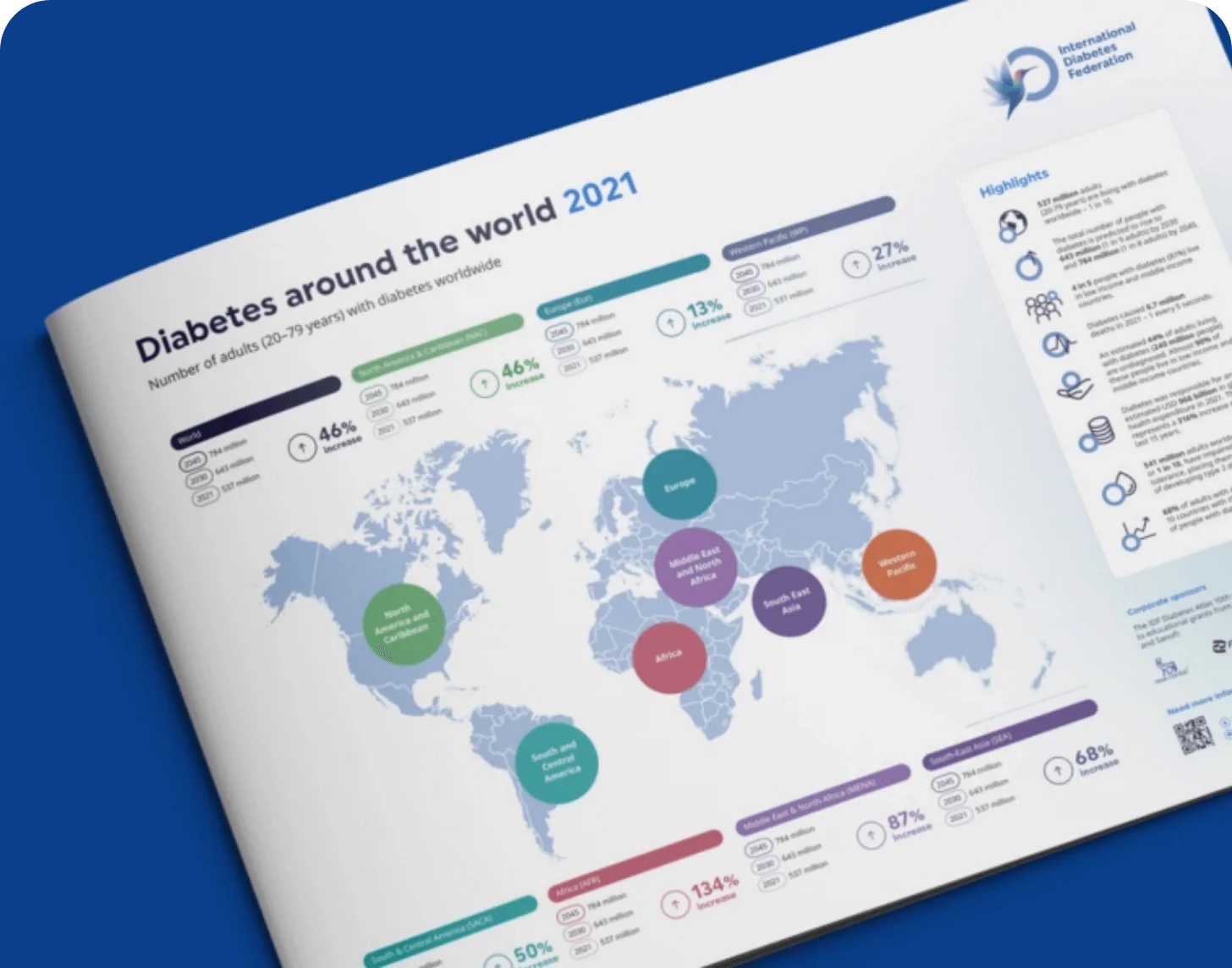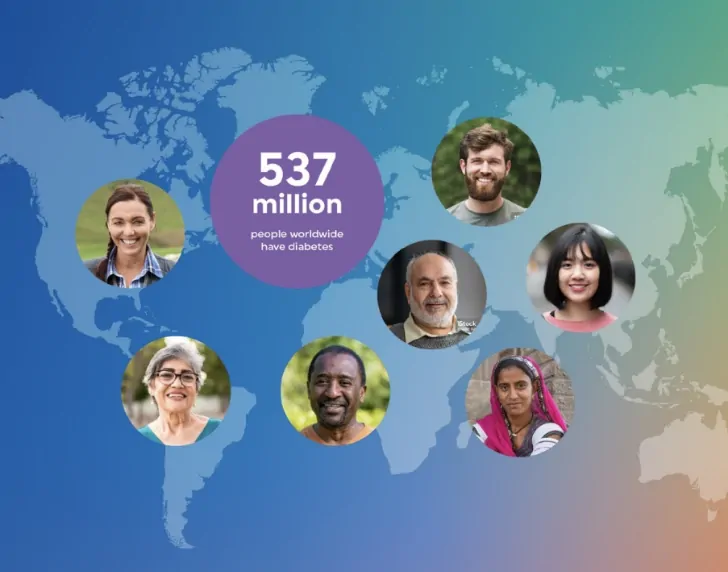Frequently asked questions
Find out everything you need to know about the Diabetes Atlas. Explore our answers on the 11th edition of the Diabetes Atlas, the research methodology, questions about the data presented and how and why levels of diabetes around the world are changing.
The IDF Diabetes Atlas is the authoritative resource on the global impact of diabetes. First published in 2000, it is produced by the International Diabetes Federation (IDF) in collaboration with a committee of scientific experts from around the world. It contains statistics on diabetes prevalence, diabetes-related mortality and health expenditure at the global, regional and national level. The 11th edition has been produced thanks to support from Sanofi (2022-2024), Novo Nordisk (2022-2023) and an educational grant (2022) from Pfizer-MSD Alliance.
- A whole chapter is dedicated to up-to-date epidemiological data on the most common diabetes-related complications.
- The impact of diabetes in older adults (>65 years old) has also been included in this edition.
- The current Diabetes Atlas presents projections for 2050 compared to the projections for 2030 and 2045 presented in previous editions. This change provides a better description of the impact of diabetes by mid-century.
- For the first time, diabetes-related mortality is presented separately for people with diagnosed and undiagnosed diabetes.
- Increased recognition of prediabetes has allowed us to report recent data on its prevalence. To better describe the total impact of the intermediate states of hyperglycaemia, prediabetes based on HbA1c-defined American Diabetes Association (ADA) criteria (HbA1c 5.7-6.4%) is included, along with the impaired glucose tolerance and impaired fasting glucose.
- The importance of the advocacy objective of the IDF Diabetes Atlas and related materials is given attention. For this purpose, a new user-friendly data portal has been developed and launched on the Diabetes Atlas website.
The data in the Diabetes Atlas comes from a variety of sources such as peer-reviewed scientific papers, and national and regional health surveys. Official reports by international organisations, such as the World Health Organization (WHO), were also assessed for their quality that was defined in consensus with an international expert panel. Data sources that passed strict selection criteria were included in the data analysis.
Confidence intervals have been produced to quantify the uncertainty around diabetes prevalence estimates. Uncertainty estimates were produced to estimate the impact of the various analytical decisions on the final prevalence estimates. These intervals therefore reflect the uncertainty levels around the diabetes prevalence estimates.
The prevalence projections for 2050 only take into account changes in age and urbanisation. They do not factor in projected changes in any diabetes risk factors (e.g. body weight). As a result, the projections are quite conservative with a wide confidence interval range.
Yes, people with undiagnosed diabetes are included in the total estimated number of people with diabetes.
Detailed estimates for the 215 countries and territories covered in the IDF Diabetes Atlas 11th Edition can be found in the “Data by location” section of this website.
The full content of the IDF Diabetes Atlas 11th Edition is available here.
All enquiries related to the data and information included in the IDF Diabetes Atlas 11th Edition can be addressed to atlas@idf.org.
The increasing prevalence of type 2 diabetes is associated with higher levels of urbanisation, ageing populations and unhealthy habits, including insufficient physical activity and higher consumption of unhealthy foods. The causes of the increased incidence of type 1 diabetes are not yet clear.
Diabetes-related health expenditure is now estimated to exceed USD 1 trillion and to account for 12% of the total global healthcare budget.
As 853 million adults (1 in 8) are projected to have diabetes by 2050, it is essential that more efforts are made to implement type 2 diabetes prevention plans and to introduce more cost-effective ways to manage the different types of diabetes.
The IDF Western Pacific region has the highest adult population aged 20-79 years old (1.7 billion). This could be one of the reasons that explain why the region has the highest number of adults with diabetes (215 million) of all IDF regions.
The data on the incidence and prevalence of children with type 1 diabetes is scarce, and mostly collected in high income countries, which may have an impact on the final numbers.
In populations of European origin, nearly all children and adolescents with diabetes have type 1 diabetes, but in other populations, type 2 diabetes is more common than type 1 diabetes in this age group.
In countries with limited access to insulin and inadequate health service provision, children and adolescents with type 1 diabetes, even when correctly diagnosed, face serious complications and consequently premature mortality. The risk factors for type 1 diabetes are also not clear, but have been linked to infections and other environmental factors.
Globally, almost half of all adults with diabetes are undiagnosed. Diagnosis rates can be improved by increasing awareness of the symptoms of type 1 diabetes (excessive thirst, increased urination, lack of energy, sudden weight loss, hunger), and increasing screening opportunities for people at high risk of type 2 diabetes (older age, overweight and obesity, family history, low level of physical activity and unhealthy diet).
Globally, one in five live births (23 million) is affected by hyperglycaemia in pregnancy. The risk of gestational diabetes increases with age. Gestational diabetes is associated with complications during delivery in both mother and child. It therefore not only affects immediate maternal and neonatal outcomes, but also increases the risk of future development of type 2 diabetes in both mother and child.

